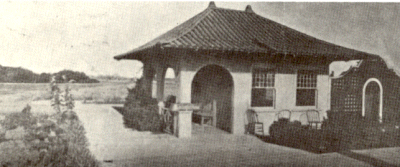The History of Hawthorne by Robert S. Hartman
In 1908, one of the first business establishments was a small grocery store on Hawthorne Boulevard. Meat was delivered by wagon 3 times a week from the Inglewood area.
and real estate office. It was located at Hawthorne Boulevard and Raymond
(120th) at the northeast corner.

1908 TO INCORPORATION IN 1922
From 1907 to 1920, population increased to over 2,000 residents. Their day-to-day needs and services were reflected by a slowly increasing business community. Jack Ramage, later to be elected Mayor of Hawthorne in 1929, started the first drug store near Broadway and Hawthorne Boulevard. The hardware store was next door. John Barton was the first plumber in Hawthorne and his sons, George and Loren, assisted him in the business. The Becker Bakery later improved to a grocery, meat market and vegetable store, was located a few doors north of Broadway on the west side of Hawthorne Boulevard. Alexander's General Store was one of the first establishments on Broadway, just a few doors west of Hawthorne Boulevard. A real estate office was located on the southwest corner of Broadway and Hawthorne Boulevard. Midway between Broadway and the present 126th Street, which was not yet cut through, on the west side of the street just south of the present railroad tracks was the Hawthorne Funeral Parlor. Clark's Feed Store was located where the present Bank of America is now standing. On the east side of Hawthorne Boulevard at the southeast corner of Hawthorne and Broadway was Coe's Restaurant, which was a gathering place for school children as well as residents who took their sandwiches and lemonade to the mission depot where they could sit on the benches, eat their food, and relax. (See photo below)
 The depot sat squarely in the middle of Hawthorne Boulevard in front of the present location of the Chamber of Commerce at 12438 Hawthorne Boulevard. The red cars to Redondo and to El Segundo, as well as the earlier steam trains, used the station as one of their main stops. Another prominent building of this era was the hotel built on Acacia to house workers in the furniture and glove factories nearby. This hotel still stands in the 12100 block on Acacia.
The depot sat squarely in the middle of Hawthorne Boulevard in front of the present location of the Chamber of Commerce at 12438 Hawthorne Boulevard. The red cars to Redondo and to El Segundo, as well as the earlier steam trains, used the station as one of their main stops. Another prominent building of this era was the hotel built on Acacia to house workers in the furniture and glove factories nearby. This hotel still stands in the 12100 block on Acacia.
Recollections | Reunions | Street Scene | Teachers | Tributes | Vietnam | What's New | Keyword Search